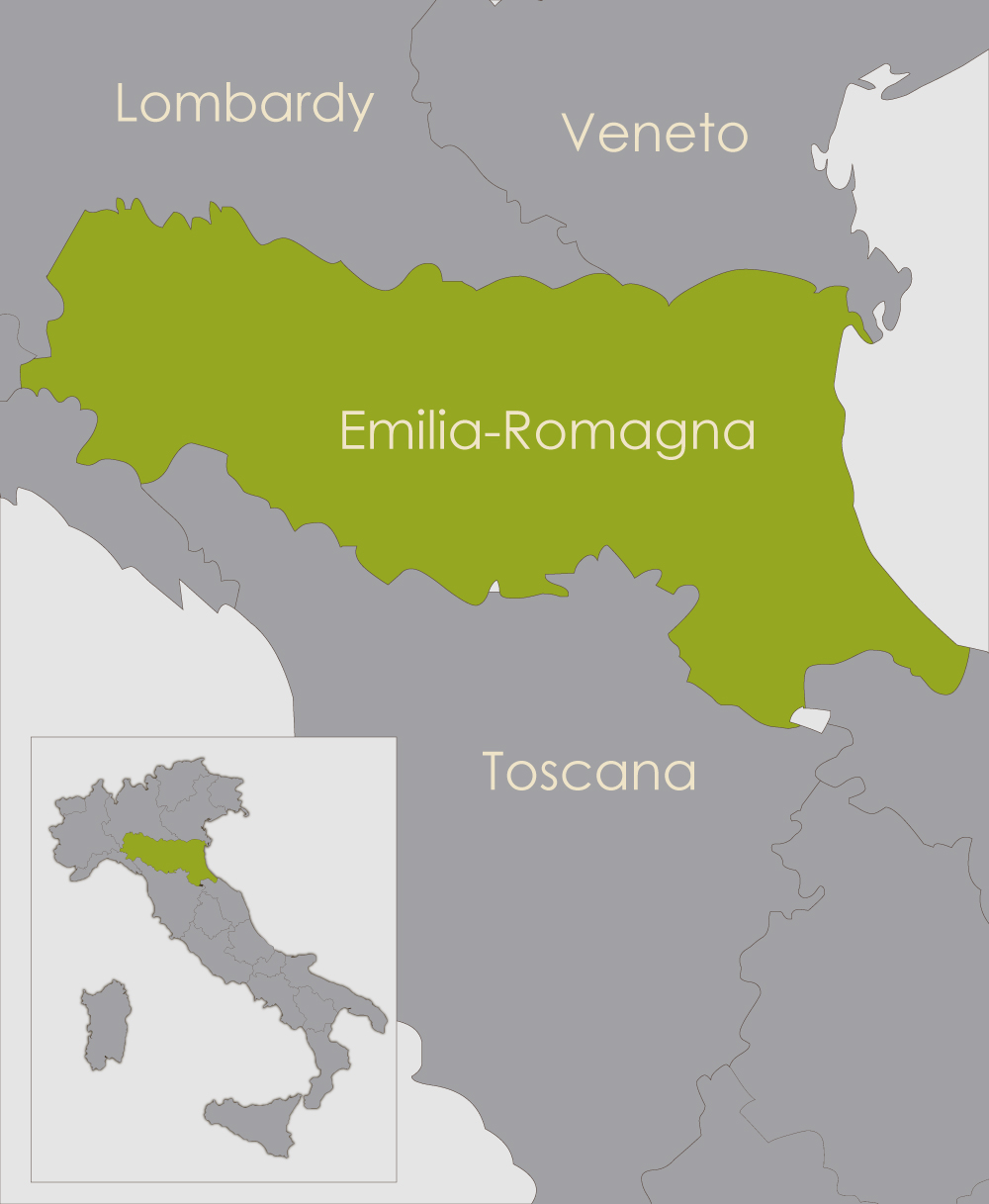 |
FAST FACTS
PRODUCERS CLETO CHIARLI, BAD SPIRITS |
OVERVIEW
Emilia Romagna is well known as a foodie mecca. Several of Italy’s most famous place-specific culinary traditions are from this region, including Parmigiano Reggiano cheese (named after the provinces of Parma and Reggio Emilia), Parma ham, and balsamic vinegar of Modena. The region’s capital Bologna is a national shrine to the culinary arts as well as the home of one of the world’s oldest universities. Emilia and Romagna are two historical areas that are conjoined in the modern region. Emilia is the larger of the two, including Bologna and the lands to the west. Romagna is the eastern coastal section, including the important cities of Ravenna and Rimini.
History: Emilia Romagna was inhabited by the Etruscans and Celts in the early days of Rome. When Julius Caesar famously brought his armies across the Rubicon River to take control of the Roman Republic, he was basically moving from Emilia Romagna into Roman territory. Not long afterward, the region was absorbed into the Roman Empire. A few centuries later, Ravenna became the capital of the Western Roman Empire for about 75 years.
After the Lombards from Germany invaded and took possession of northern Italy, Ravenna and the rest of Romagna were held for a while by the Byzantines. This area, along with Bologna, eventually became part of the territory ruled directly by the Pope in Rome. The rest of Emilia became fragmented into duchies under the Holy Roman Emperor. Powerful families such as the Este reigned for centuries in Modena, Ferrara, Piacenza, Parma, and Reggio. Most of the duchies and the Papal States survived until the late stages of the Italian reunification, but ultimately became part of the Kingdom of Italy in the mid-19th century. Emilia and Romagna were joined as a single region in 1947.
Geography: Emilia Romagna lies at the top of the Italian Peninsula, stretching from the Adriatic Sea almost all the way west to the Ligurian Sea. The long northern border of the region is defined for the most part by the Po River, whose broad valley is generally a flat, fertile plain that is home to the greatest concentration of Italy’s agriculture. The farmland reaches southward until the terrain abruptly rises to the southwestern border, formed by the spine of the Apennine Mountains. The eastern end of Emilia Romagna is a long line of beaches on the Adriatic.
Climate: The climate of Emilia Romagna is similar to other areas of the Po Valley—a subcontinental regime with hot, muggy summers and cold, extended winters. Precipitation is relatively uniform from month to month, with slightly more in the spring and fall. Snow is not uncommon in the winter. Along the Adriatic coast, the temperature variations are moderated a bit.
Primary grape varieties: The history of the region has led to a significant difference in the viticulture of Emilia and Romagna. Romagna, to the east, is dominated by Trebbiano (specifically the varieties Trebbiano Romagnolo and Trebbiano Toscano) and Sangiovese. In Emilia, west of Bologna, those grape varieties are almost nonexistent, and the vineyards are instead planted heavily to Lambrusco along with other red grape varieties like Ancellotta, Barbera, and Croatina. White grape varieties are in short supply in Emilia, but the main one is Grechetto. International varieties are present but not in great abundance in Emilia Romagna.
Key wine regions: Emilia Romagna is best known for its effervescent Lambrusco-based wines, and there are a few denominations that focus on these. The leading ones are a trio in the province of Modena in the center of Emilia Romagna. These denominations form a continuous area, with Lambrusco Grasparossa di Castelvetro DOC surrounding the city of Modena, Lambrusco di Sorbara DOC just to the north, and Lambrusco Salamino di Santa Croce DOC farthest north, reaching almost to the Po River. These three zones are each the home of a different member of the Lambrusco family of grape varieties—namely, Lambrusco Grasparossa, Lambrusco di Sorbara, and Lambrusco Salamino. More or less overlaying the trio is Modena DOC, a larger denomination that also produces mainly Lambrusco-based wines.
For white wines, the most important denominations of Emilia Romagna are Pignoletto DOC and Colli Bolognesi Pignoletto DOCG, both of which make Grechetto-based wines in the area around Modena and Bologna. Another denomination of note is Romagna Albana DOCG, the first DOCG-level white wine of Italy, made with the little-known Albana grape variety.
Cuisine: Known for great food, Emilia Romagna is particularly adept at cured meats (salumi) and pastas. Prosciutto is Italian ham, from the thigh or hind quarter of a pig, which is usually aged and salted but not cooked; it is then sliced very thin when served. Prosciutto is made in many regions, but Emilia Romagna is a major source, with such DOP-level examples as Prosciutto di Parma, Prosciutto di Parma, and Culatello di Zibello. Mortadella di Bologna is a spiced, cooked pork-and-lard loaf that is imitated as bologna or baloney in the United States. And one of two Italian DOPs for pancetta (bacon) is Pancetta di Piacenza.
Pasta is a high art form in Emilia Romagna. Egg pasta is the norm. Tortelli are a specialty—squares of pasta filled with ricotta cheese and/or meat and usually served simply in butter or perhaps in a broth; small ones are called tortellini, and oversized ones are tortelloni. Other shapes of pasta are served, of course, such as tagliatelle (narrow flat noodles) and lasagne (very wide flat noodles). The classic sauce is ragù alla bolognese, a meat sauce (beef or veal and possibly pork) with tomato puree, celery, and carrots. Lasagna alla bolognese, on the other hand, uses a béchamel sauce and typically green lasagna noodles.

